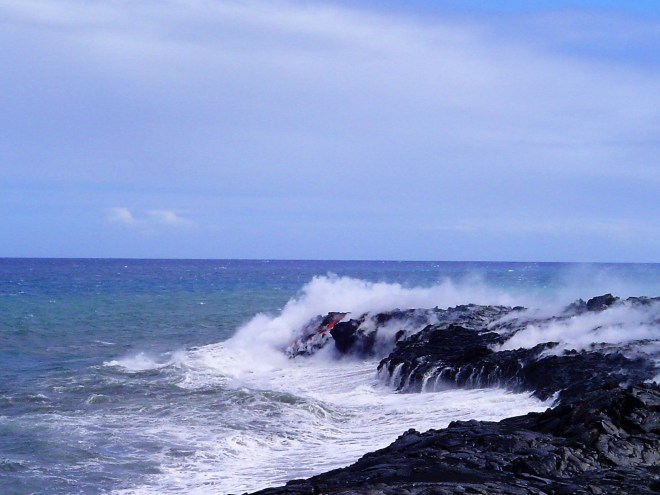The sixth and final installment of my short, but amazing trip to the Big Island of Hawaii, Rarotonga in the Cook Islands, and Samoa. I finally squeezed in some sightseeing in Samoa in spite of my continued transport challenges. All part of the journey.
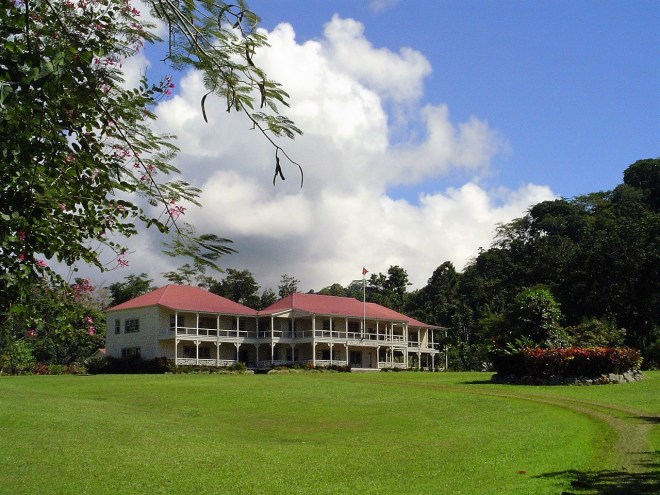
Robert Louis Stevenson’s house at Vallima
My first true morning in Samoa, I needed to confirm my ticket back to Pago Pago. This was always a risk, as I had only four days in Samoa (including my arrival day) and a plane to catch back to Honolulu from Pago Pago. But I thought much of my trip thus far had been relatively “safe” and what was travel without a little risk? Pale, the Polynesian Airlines guru, worked his wonders. He booked me on a Polynesian Airlines flight at 7 PM on Wednesday arriving in Pago Pago before 8 PM, giving me a comfortable margin to check-in for the 10:30 PM Aloha Airlines flight back to Hawaii. The flight was even departing from Faleolo Airport, the large international airport on the Western end of the main island of Upolo, rather than the small airport just minutes from Apia called Fagali’i. This would make it possible for me to go over to the island of Savai’i and return by boat and encounter less hassle to go to the airport, as Faleolo is just a few minutes down the road from the ferry port. I should have realized I was taking far too much for granted – but more on that later.
In the afternoon of my second day I headed to the home of Robert Louis Stevenson, the famous Scottish author of Treasure Island and Strange Case of Dr Jekyll and Mr Hyde. Incredibly, due to his often-poor health and his doctor’s advice to seek other climes, he and his family left Scotland in 1887, traveled to America, and then onward the following year for many adventures in the South Pacific, eventually buying land and building a home in Samoa. Ultimately, his mother, wife Fanny, stepchildren Lloyd and Belle, and Belle’s son’s Austin too settled in Samoa. Stevenson was popular among the Samoans and when he died there some four years later he was accorded rites fitting someone of great stature and is buried not far from his home. I could not help but think of the incredible travels Stevenson and his family, and other literati of the period like Melville and Twain, undertook. I did not have the easiest time getting to Samoa, but it was certainly easier than their trips would have been. I became quite entangled in these thoughts while enjoying the Stevenson house and photographs on display. I think I was most impressed by Robert’s dourly dressed mother making the long journey.
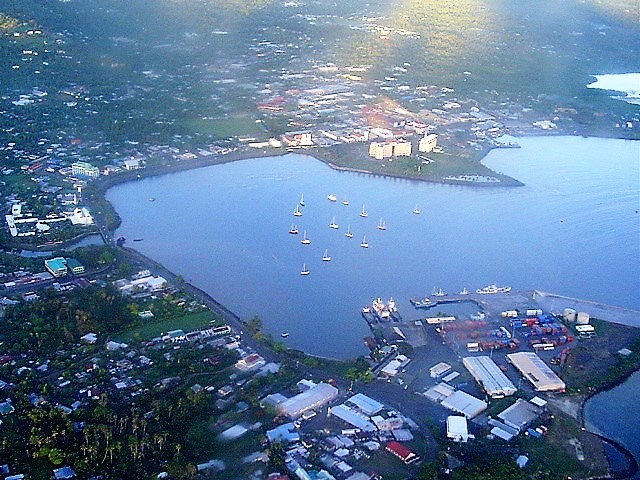
View of Apia Harbor on my flight to Savai’i
Again, in writing it appears I did very little, but I felt the day quite full and pleasant. I had lovely meals in waterfront restaurants, wrote some email, and arranged my tickets back to Pago Pago and onwards to Savai’i. I also arranged for my bag to take a tour of Upolo Island and meet me at the ferry port to go to the airport, as I was notified my six-seater plane to Savai’i would take only five kilos. At first the thought of abandoning much of my belongings for a day and a half threw me, and then I felt oddly liberated to have only the small pack with me. In fact, I found I had no need for anything I left behind.
Early in the morning of the third day, I boarded the small jet for the 20-minute flight to Savai’i. I checked in at 6:30 for the 7 AM flight. About five minutes before 7 an airline official approached me and asked if I was going to Savai’i. When I said yes, he told me it was time to board. He stepped over to an open door and then proceeded to take my boarding pass. It turned out I was the only passenger. Yes, it was just myself and the pilot on this flight. And my five kilos of luggage.
The view was beautiful; I cannot begin to describe it. Like the other islands of the Pacific, Samoa is the product of volcanic action. Though smaller than the Hawaiian Islands, it was most certainly larger than Rarotonga. There was the low flat area along the coast, a wide lagoon encircling much of the island, and then sudden sharp peaks in the interior. And although I heard deforestation is a major problem in Samoa, the islands of Upolo and Savai’i seemed very, very green. We flew across the channel and saw the two small islands there and the ferry steaming across to land in Savai’i port. The airport was a very small wooden building with a single airstrip surrounded by a jungle of palms. I felt very much I was flying somewhere far from civilization, but there was indeed a road, and soon my tourist van picked me (and my five kilos of luggage) up to begin our tour.

At the Taga Blowholes
We picked up a passenger at the seaport, but deposited her soon at her accommodation and the Savai’i Circle Island Tour became T—-‘s personal Savai’i tour. Much of the Circle Island tour was simply driving around the island. It took quite some time as Savai’i is the largest island in Polynesia outside of Hawaii & New Zealand. Yet despite its size it is sparsely populated, only a two-lane road circling the island. No roads in the interior except those that lead to plantations. Very small villages hug the road at intervals. But there are stretches absent of population, often around lava flows where the land is simply hard solidified lava. I waded with sea turtles and viewed the rainforest from a 30-foot high suspended forest walkway.
The best stop was at the Taga Blowholes, the largest blowholes in the world. That day the waves were hard and high, and the blowholes then shot water high into the air, maybe as high as 50 feet. There was a tremendous “Whoosh” sound as the pressure in the holes would build and the sea water was forced into the air. Standing some 50-feet away, I was still dusted with a salty spray.
Though the tour was to also include a visit to the only waterfall on the island and a historical site, those were off the itinerary because, as my tour guide told me, there was an active court case involving the land. This was disappointing as these are supposed to be two of the best sites on the island, but there was little I could do about it. The weather was turning, the sky darkening, and some rain falling; I was tired and happy to go to my guesthouse.
I stayed at the Lagoon Chalets; a place that had come well-recommended. I paid nearly US$25 to stay in a two-mattress shack. This shack came with four walls, a roof, a floor, a shelf, and a bare light bulb. I was told the light was a special touch not often found in such places. The $25 also included two meals, though there was a limited menu to choose from. Actually, there was no menu–you just ate what the manager and the assistant were having. And it consisted of rice, taro root with coconut sauce, shredded cabbage, carrot, and beet salad, and fish of the day or noodle soup. It was okay for one night; I could not imagine having taro root with coconut sauce day in and day out. I had an early night in my room, reading by my bare light bulb, then falling asleep to the lapping waves.

Wading with sea turtles (they like mango)
I tried some more lazing about the next day. I was to be on the 2 PM ferry back to Upolo and the ferry terminal was a 20-minute walk down the road. I woke up and lazed in my chalet/shack. I had a simple breakfast of eggs, tea, and toast. I went down to the mini dock, and read a book while sitting on a picnic bench. Then I simply lay on the deck in the sun. I moved back to my chalet/shack. Back to the dining area. Back to the dock. And so on. I could never laze in one place for too long and there were only so many lazing places in the guesthouse area. The hours until 1:30 dragged. Then suddenly it was time to go.
I caught a ride with two other guys heading for the ferry. I bought a water and a Baby Ruth bar before jumping on the ferry. I did not want to have too much in my stomach on this boat. I embarked, took my motion sickness tablet, some water, plus a fruit leather and half a small bag of walnuts. In less than ten minutes after the boat was underway, I regretted having eaten anything at all. The boat was listing heavily from side to side. It seemed we were moving more back and forth than we could possibly be moving forward. There was a great heave and a creak as we listed left and then a pause before we rushed back to the right. Despite being next to the overworked air conditioner, I began to sweat. I needed to make a decision: either remain immobile the entire journey, laying prone on the front bench by the air conditioner, breathing heavily, and trying to keep my stomach down – or find a restroom quickly and be rid of anything that was sloshing about my stomach. But I knew once I stood up, the time frame to find the restroom was going to be limited.
I bolted upright, scanning the room. The cold sweat beading on my upper lip. I saw nothing but seats. The act of moving my head to look around was extremely unpleasant. I felt a rise in my throat; I took a deep breath. I stood and began to walk to the stairs down into the car area. My balance was off terribly. I stumbled around like a drunk. Nothing appeared to be downstairs. I could see several people laying as still as possible, eyes rolling into their heads, most certainly feeling much the same as I did. I continued my search for a restroom, groping at benches as I was thrown from one to the other. I tried to keep the panic down. I found the restroom. It was pitch-black, the only light coming from when the door would rapidly swing open on a list. Inside the restroom was like a boiler room. The air was humid and stagnant. I was sweating profusely. It was as if I were in the height of a malarial fever. In the dark I found the stall, and well, you know. I felt weary and slightly disoriented. After maybe ten minutes I clumsily made my way back to the front bench in front of the blessed air conditioner, the television was screening the movie “Free Willy 3;” I lay down. I rest quietly immobile for the rest of the hour and 20-minute journey. Disembarking made me very happy.

Rainforest walkway
Then came yet more of the Samoan transport waiting game. My bag, having completed its tour of Upolo, joined me at the ferry terminal. Once reunited, the driver dropped my bag and I off at the Faleolo Airport three hours before the 7 PM flight. Despite being the Samoa International Airport, there was almost nothing there. There was a bank and a restaurant, but locked up tight. There were also terribly uncomfortable plastic chairs, an ATM, and a restroom. Luckily, I still had a book to read. I chatted with a Spanish couple. I tried various positions to comfortably read my book in those plastic chairs. Eventually time moved forward and the check-in officials arrived 30 minutes before the flight. By 7:30 PM we were all waiting for immigration to open. Once through immigration (in record time), an announcement comes on informing us the flight had been cancelled due to a broken plane. No one moved. The announcer tried again. This certainly elicited reactions. Lots of swearing and declarations of “no way” and “you have got to be kidding” from the Westerners. The Samoans and the family from Tonga weren’t happy, but they had more resigned reactions. We all filed back through immigration, received our departure tax money again, and then went to wait at the check in counter. There would be no more flights until the next day. I would miss my connecting flight to Honolulu.
I accepted hotel accommodation in Apia offered by the airline. The next day I had to return to the Apia airline office. Despite having been told all flights to Pago Pago were full, an agent managed to get me on a 2:25 PM flight and rebooked me on an 11:30 PM flight to Honolulu. After five and a half pointless hours at Faleolo airport the day before, I also had the grand opportunity to spend a further eight hours in the equally thrilling Pago Pago airport.
Looking back, I did not see as much of Samoa as I would have liked, but in the visit, I was happy and busy, even considering the long and frustrating transport waiting times. Overall, I accepted that things just move on their own flexible schedules in Samoa and the people are very kind.
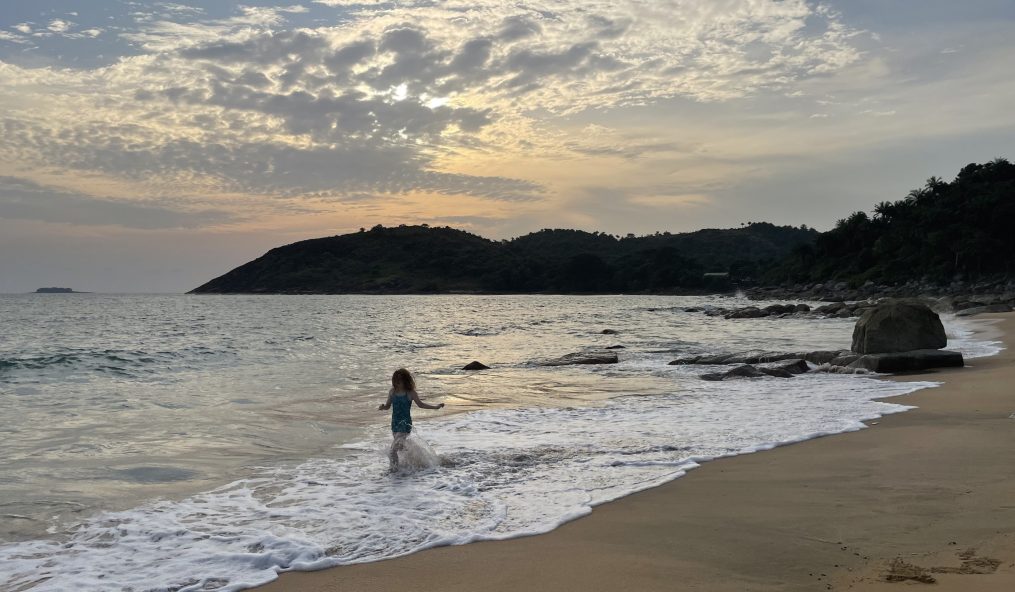




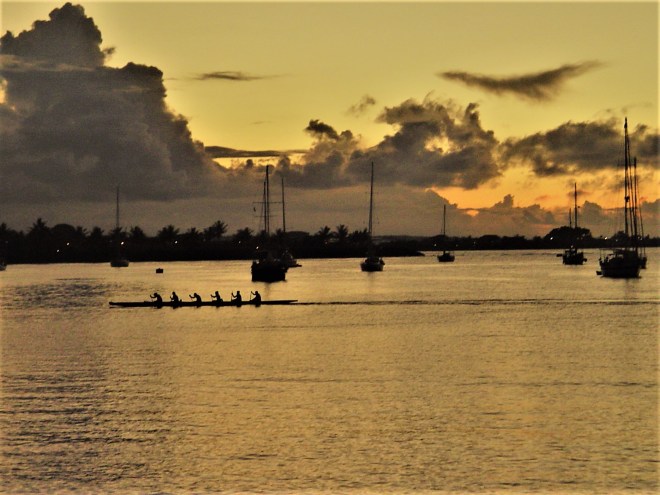

 That night I joined the other hostellers in a trip to a local dance spot/bar. I was a wee bit reluctant to go (I am neither a drinker nor abar fly). They were all playing drinking games to prepare for going out. I read a book. But I decided I might as well go. While there, I started to feel a bit old. Though there were certainly all ages in the crowd, I would say most were in their early twenties, and most were very keen on drinking as much as they could. Still, the place was going to hold a dance contest, and I like dancing. I start dancing with Jay, another guy from the hostel. After the initial dancing was over, I was just standing by the side when the judge came up and asked me who my partner was. I pointed at Jay. The judge says, okay, you two are the final couple in the contest. Our mouths hung open. It turned out to be a contest of foreigners dancing to Cook Island music. Basically, we had to dance like Cook Islanders. We danced our little hearts out – I tried to remember anything from when I studied Polynesian dance as a child. We came away as runners up, winning a case of vodka drinks. Ha! Just what a teetotaler who rarely goes to bars wants – Jay was pretty happy though. I felt pretty impressed with myself. I trekked for four hours AND danced away in a manic Cook Islands dance contest in the evening (along with two hours more of dancing) – maybe I was not that old after all?
That night I joined the other hostellers in a trip to a local dance spot/bar. I was a wee bit reluctant to go (I am neither a drinker nor abar fly). They were all playing drinking games to prepare for going out. I read a book. But I decided I might as well go. While there, I started to feel a bit old. Though there were certainly all ages in the crowd, I would say most were in their early twenties, and most were very keen on drinking as much as they could. Still, the place was going to hold a dance contest, and I like dancing. I start dancing with Jay, another guy from the hostel. After the initial dancing was over, I was just standing by the side when the judge came up and asked me who my partner was. I pointed at Jay. The judge says, okay, you two are the final couple in the contest. Our mouths hung open. It turned out to be a contest of foreigners dancing to Cook Island music. Basically, we had to dance like Cook Islanders. We danced our little hearts out – I tried to remember anything from when I studied Polynesian dance as a child. We came away as runners up, winning a case of vodka drinks. Ha! Just what a teetotaler who rarely goes to bars wants – Jay was pretty happy though. I felt pretty impressed with myself. I trekked for four hours AND danced away in a manic Cook Islands dance contest in the evening (along with two hours more of dancing) – maybe I was not that old after all?




 On Sunday morning I attended church at the Cook Islands Christian Church (CICC). The service was mostly in Maori, the traditional language of the Cooks. The local patrons were dressed in their finest – with women in colorful flower-patterned dresses and traditional straw hats; the men in flowered shirts. The pews and beams and pulpit are made of a warm reddish medium wood, while the walls are a white stucco and the ceiling painted an aquamarine green – the kind popular in the sixties. Though it seemed an odd color in and of itself, it worked in this church with its simple stained-glass windows. Those sitting in the center section were clearly the most serious of church goers. They stood up first for songs, sang the loudest, and sat down last. They were also the best dressed. Those on the lower section’s outer seats seemed the second tier of church goers. Maybe they had not arrived quite in time to claim the middle seats for the day, but they were still dressed in their colorful finest and sang the hymns with vigor.
On Sunday morning I attended church at the Cook Islands Christian Church (CICC). The service was mostly in Maori, the traditional language of the Cooks. The local patrons were dressed in their finest – with women in colorful flower-patterned dresses and traditional straw hats; the men in flowered shirts. The pews and beams and pulpit are made of a warm reddish medium wood, while the walls are a white stucco and the ceiling painted an aquamarine green – the kind popular in the sixties. Though it seemed an odd color in and of itself, it worked in this church with its simple stained-glass windows. Those sitting in the center section were clearly the most serious of church goers. They stood up first for songs, sang the loudest, and sat down last. They were also the best dressed. Those on the lower section’s outer seats seemed the second tier of church goers. Maybe they had not arrived quite in time to claim the middle seats for the day, but they were still dressed in their colorful finest and sang the hymns with vigor.


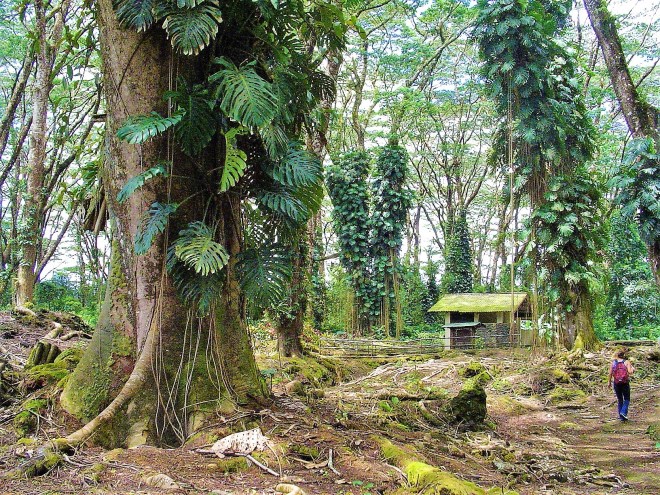


 Nowadays the Historical Park is peaceful. The wall of the compound is all that still exists from traditional times beside white sand, a glittering sea, and reconstructed straw huts. In one large boat house, an old native Hawaiian carves the traditional totem or Ki’i that guard the entrance to the landing lagoon reserved only for ali’i, and the site of some reconstruction, from evil spirits. In the small lagoon a sea turtle swam around, another basked in the sun.
Nowadays the Historical Park is peaceful. The wall of the compound is all that still exists from traditional times beside white sand, a glittering sea, and reconstructed straw huts. In one large boat house, an old native Hawaiian carves the traditional totem or Ki’i that guard the entrance to the landing lagoon reserved only for ali’i, and the site of some reconstruction, from evil spirits. In the small lagoon a sea turtle swam around, another basked in the sun.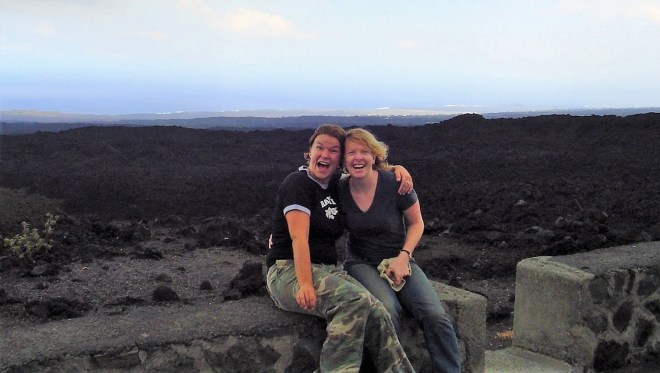


 As we bid Sharifa farewell at the airport, I made a reservation for my own rental car the next day. This was a big deal for me as I could not recall the last time I had driven a car. The Kona hostel, located in a residential area, was not easy to find because there was not a sign at all. The manager had a weird laugh after just about everything he said. He was young, around 30 years of age, and although he laughed, he did not seem pleasant. Carmen immediately told me in the room she did not want to stay there another night. I also felt bad karma from that guy. The hostel was new and clean, but the guy made the whole thing feel like an episode of the Twilight Zone. Carmen and I walked down to the supermarket to get fixings for dinner and spent an early evening in the hostel reading, showering, watching tv, and eating.
As we bid Sharifa farewell at the airport, I made a reservation for my own rental car the next day. This was a big deal for me as I could not recall the last time I had driven a car. The Kona hostel, located in a residential area, was not easy to find because there was not a sign at all. The manager had a weird laugh after just about everything he said. He was young, around 30 years of age, and although he laughed, he did not seem pleasant. Carmen immediately told me in the room she did not want to stay there another night. I also felt bad karma from that guy. The hostel was new and clean, but the guy made the whole thing feel like an episode of the Twilight Zone. Carmen and I walked down to the supermarket to get fixings for dinner and spent an early evening in the hostel reading, showering, watching tv, and eating.